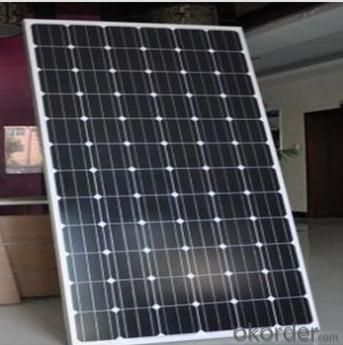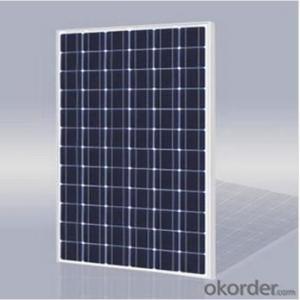CNBM Poly Solar Panel 260W A Grade with Factory Price
- Loading Port:
- Shanghai
- Payment Terms:
- TT OR LC
- Min Order Qty:
- 100 watt
- Supply Capability:
- 100000 watt/month
OKorder Service Pledge
OKorder Financial Service
You Might Also Like
Item specifice
CNBM Poly Solar Panel 260W A Grade with Factory Price
Production description
A solar panel is a collection of solar cells. Lots of small solar cells spread over a large area can work together to provide enough power to be useful. The more light that hits a cell, the more electricity it produces, so spacecraft are usually designed with solar panels that can always be pointed at the Sun even as the rest of the body of the spacecraft moves around, much as a tank turret can be aimed independently of where the tank is going.
A photovoltaic (in short PV) module is a packaged, connected assembly of typically 6×10 solar cells. Solar Photovoltaic panels constitute the solar array of a photovoltaic system that generates and supplies solar electricityin commercial and residential applications. Each module is rated by its DC output power under standard test conditions, and typically ranges from 100 to 365 watts. The efficiency of a module determines the area of a module given the same rated output – an 8% efficient 230 watt module will have twice the area of a 16% efficient 230 watt module.

Application
Aerospace
Residential
Commercial
Large solar power plant
Distributed plant
Product Feature
1.A grade high efficiency solar cells.
2.TUV/UL/CE/CEC etc
3.Fast shippment
4.25 years warranty
5.OEM
Package
24pcs into one carton, 312pcs into a 20 foot container, 728pcs into a 40 foot container.
- Q:what percentage of sunlight is converted into electrical energy in a solar panel?
- Depending on the type of solar panel, any where from 6% to 42.8%.
- Q:Can solar panels be used in agriculture?
- Yes, solar panels can be used in agriculture. They provide a renewable and clean source of energy that can power various agricultural activities such as irrigation systems, lighting, and machinery. Additionally, solar panels can be installed on agricultural buildings or unused land, allowing farmers to generate their own electricity and reduce their carbon footprint.
- Q:I have had this 2v portable Solar Panel for my apartment for awhile. Only problem is that I have no balcony and I can barely get enough sun to use it with my Cobra 450 400-800 watt outlet converter. Can someone advise me a better method to use these? Like do I have to get more 2v solar panels? I have a small apartment and use it on one window. Also is it possible for me to buy a portable storage tank to store the energy gathered from the sun by the solar panel?
- Like others have reported, the voltage may well be 2v, however the amperage is approximately .0 amps Thats the capability of photograph voltaic. relatives shops are monsterously greater useful. yet, the voltage is there, and the amperage is there, including that's- so, that photograph voltaic panel might desire to cost up a monetary business enterprise of four 2v batteries under pressure jointly in parallel.... it in simple terms could take approximately 3 weeks. it can be a great trickle cost. I play around with little 6v photograph voltaic cells, and in case you choose to work out it artwork, positioned a huge can capacitor around the photograph voltaic cellular leads for a minute or 2, then touch the capacitor to the motor leads... it is going to turn- proving the capability is actual. you in simple terms desire the Capacitor to save it up for slightly. interior the tip all of us have been given spoiled on the quite extreme performace capability of plug in electrical energy and chemical cellular batteries. Given the designed capability of those, any option source of capability is confident to be disappointing.
- Q:How do I choose the right size of solar panels for my home?
- To choose the right size of solar panels for your home, you should consider factors such as your average electricity consumption, available roof space, and budget. Start by calculating your average monthly electricity usage, and then determine how much of that you want to offset with solar power. Consider the size and orientation of your roof to evaluate the available space for panels. Additionally, assess your budget and the financial feasibility of the installation. Consulting with a solar professional or installer can provide valuable guidance tailored to your specific needs and help you make an informed decision.
- Q:I'm thinking of having solar panels to generate electricity. The drawbacks are that I'm afraid if it needs repair, I won't be able to find anyone. Also I'm afraid that the roof is not very accessible. If it is a new house, should the roof have a roof hatch? What can make the system not work?
- Modern solar electric panels rarely fail. Because of this, if you would be installing them over a roof that only has a few years left on it, it would be better to redo the roof, first. In the unlikely event that a panel needs to be changed, this can be done in 30 minutes or so, because the panels are mounted on racks, with everything simply plugging together. I have never personally seen a solar installation go bad, but from what I hear, the inverter (a box that goes in next to your electric service panel) is usually what burns out after 5 years, assuming the install was done right in the first place. If you were to call roofers to repair your roof, they would somehow be able to get to your roof, by ladders, or a special truck. Solar installers use the same kind of equipment. They won't have a problem getting up there. A solar electric system is actually a very straightforward thing. No matter who installs it, if there is a problem, another installer should be able to diagnose and fix it.
- Q:How do solar panels affect the roof's structural integrity?
- Solar panels do not significantly affect the roof's structural integrity when properly installed. The panels are mounted on a rack that evenly distributes the weight, and professional installers ensure that the roof can handle the additional load. In fact, solar panels can even provide some protection to the roof by shielding it from the elements.
- Q:Can solar panels be used for powering construction sites?
- Yes, solar panels can be used to power construction sites. They can provide a reliable and sustainable source of energy to run various equipment and tools used in construction, including lighting, power tools, and machinery. Solar panels can help reduce reliance on traditional fossil fuels, lower energy costs, and minimize the environmental impact of construction activities.
- Q:Can solar panels be installed on a university or college campus?
- Yes, solar panels can be installed on a university or college campus. In fact, many educational institutions have already embraced renewable energy and have successfully installed solar panels on their campuses. These panels can help offset the electricity consumption of the campus, reduce carbon emissions, and provide a hands-on learning opportunity for students interested in sustainability and renewable energy.
- Q:Hi! I bought a Coleman 2 vdc cooler that pulls 9 amps. What size solar panel and amp-hour battery do I need? I only open it 3 times a day. It will hold about 3 gals of milk.
- If it pulls 9 amps continuously, that's 08 watts/hour or about 2.5 kwh/day. If it only pulls half that (does it cycle?) it's about .2 kwh/day. You only want to drain a lead-acid battery 50% or so, so you'll want a 5 or 2.5 kwh battery pack. A typical setup for the 5 kwh would be two L-6 batteries in series, and for the 2.5 kwh you could use 2 T-05 batteries in series. This does not account for days of cloud. If you regularly have cloudy days, size the battery pack for two or three days of use with no input (2-3 x the sizes given above). To charge them, you typically want panels that will charge your battery at least 5% of its capacity per hour (C/20). For 2 volt nominal panels that's 0 amps for the T-05 or 20 amps for the L-6 batteries. It's good to have more than that for battery life (it cuts down on what's called stratification), so you'll want probably 50-200 watts of panels for the T-05 and 300-400 for the L-6. You'll also need a charge controller. Peltier coolers are very inefficient. You'll save money by using a regular mini-fridge and an inverter. Most mini-fridges only draw 50 watts or so, so you're talking 600 watt-hours for a 50% duty cycle. This means two T-05 batteries will give you two days of use and you'll only need 20-50 watts of panel. DK
- Q:so...do you think an online store dedicated to selling solar panels/systems will be a good business idea? Since green energy is the 'hottest' growing business area recently with usage growing about 30% per annum and investors putting all their money into solar energy, wind farms, biofuel, etc. I think when you sell solar systems online this will be the most appealing business model to the end customer...especially if you offer free installation on orders of say $000.
- It's that offering installation that is the problem. Do you have the ability to arrange contractors to install where ever the customer may be? The online store model works best on a drop ship model where once you've shipped the parcel, you're done. Online selling of solar panels would be basically to the DIY crowd and as you've said, most people don't have the skills nor the enthusiasm to install them. The current price per watt installed is about $0 a watt. $ per watt are the organic dye and film solar panels which are horrendously inefficient and require much more square footage and that $ per watt price is before installation. Currently solar depends a lot on government subsidies to be worthwhile. The various green energy technologies (both solar and wind) lack the economics to be anything other than greenwashing and often if you consider the total impact to the environment, they are often worse than fossil fuels and even if the environmental impact of their manufacture is neglected, it's hard to compete with fossil fuels where nature has done all the work of storing solar energy in a convenient hydrocarbon form. Of course, there's still money to be made off people's ignorance. You've already asked this question several times, apparently you're not satisfied with any answers that are counter to your hopes. Why don't you try it and see how far you'll get.
1. Manufacturer Overview |
|
|---|---|
| Location | |
| Year Established | |
| Annual Output Value | |
| Main Markets | |
| Company Certifications | |
2. Manufacturer Certificates |
|
|---|---|
| a) Certification Name | |
| Range | |
| Reference | |
| Validity Period | |
3. Manufacturer Capability |
|
|---|---|
| a)Trade Capacity | |
| Nearest Port | |
| Export Percentage | |
| No.of Employees in Trade Department | |
| Language Spoken: | |
| b)Factory Information | |
| Factory Size: | |
| No. of Production Lines | |
| Contract Manufacturing | |
| Product Price Range | |
Send your message to us
CNBM Poly Solar Panel 260W A Grade with Factory Price
- Loading Port:
- Shanghai
- Payment Terms:
- TT OR LC
- Min Order Qty:
- 100 watt
- Supply Capability:
- 100000 watt/month
OKorder Service Pledge
OKorder Financial Service
Similar products
New products
Hot products
Hot Searches
Related keywords




























